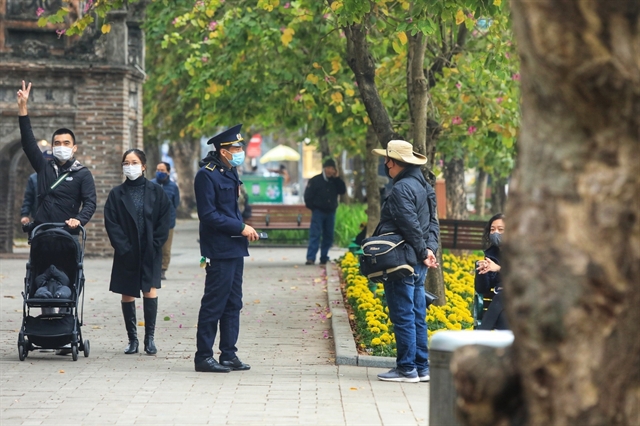Why COVID-19 caseload and death toll on the rise: MoH
Although the pandemic situation in the country is fundamentally under control, new infections and fatalities are still being recorded.
 |
| An officer reminding people around Hoan Kiem Lake in Ha Noi to ensure preventive measures against the pandemic. — VNA/VNS Photo Tuấn Anh |
The Ministry of Health says there are a number of reason for the increase in numbers, including the resumption of many social activities and transportation.
They also say the virus has already been spreading inside the community and the highly-infectious Delta and Omicron variants are still threatening to cause another large-scale outbreak.
But the ministry warned that there have been signs of negligence from the community in pandemic prevention and control, with people not following the 5K measures (Masks, Disinfection, Distance, No gathering, Health declaration) in public spaces.
The MoH also said that for people who had vaccines earlier, their immunity against the virus wanes over time, while the newly-inoculated need time to produce antibodies.
Statistics reveal that most of the fatalities occur in the senior population, and those with underlying health conditions that prevent them from getting the vaccine.
HCM City reported 93 per cent of COVID-related deaths were patients aged 70 and above, with many having two or more underlying diseases.
With international flights resuming from January 1 and the upcoming Tet (Lunar New Year) holiday, the MoH requires localities to strengthen pandemic control and prevention measures, focusing on early detection and treatment for serious cases.
The ministry also highlighted that vaccine is the strategic factor that will decide the immediate and long-term future in the fight against COVID-19.
Departments and units are required to stay on high alert for the new variants, and focus on the vaccination drive (including booster shots), especially for high-risk groups.
At-home treatment will continue to be provided for SARS-CoV-2 patients of low and moderate risk to avoid overloading in hospitals.
Access to medical services, medicines, and health monitoring must be ensured for these people, said the MoH.
Dr Tran Dac Phu, former head of the General Department of Preventive Medicine also emphasised that vaccine was the most important ‘mindset’.
He added that he “always recommend people to practice the MoH’s 5K measures all the time. We have to stay alert in case that the people next to us, or even ourselves, have been infected.”
As of January 3, Viet Nam has recorded 1,778,976 infections along with 33,021 since the beginning of the pandemic. The country has been recording on average 15,629 new cases per day for the past week.
According to the Department of Medical Examination and Treatment Management under the MoH, 6 per cent of the infections recorded in Viet Nam are severe cases, 8.3 per cent are moderate, while 85.7 per cent are cases with mild to no symptoms.
Of the total COVID-related deaths, 47 per cent are patients aged over 65 with underlying health conditions; 36 per cent are people aged 50 to 65; 15 per cent for the 18 to 49 age group; and 0.42 per cent for the population aged 0 to 17.
Source: VNS